
York is the oldest inland town in Western Australia, situated on the Avon River, 97 kilometres (60 mi) east of Perth in the Wheatbelt, on Ballardong Nyoongar land, and is the seat of the Shire of York.

Stirling Gardens is a small public park in Perth, Western Australia.

Council House is a 13-storey office building on St Georges Terrace in Perth, Western Australia. Located beside Stirling Gardens and Government House in the city's central business district, the 49.8-metre (163 ft) building was designed by Howlett and Bailey Architects and opened by The Queen in 1963, after Perth hosted the 1962 British Empire and Commonwealth Games. For most of its history, it has served as the headquarters for the City of Perth.
Australian non-residential architectural styles are a set of Australian architectural styles that apply to buildings used for purposes other than residence and have been around only since the first colonial government buildings of early European settlement of Australia in 1788.

George Thomas Temple-Poole was a British architect and public servant, primarily known for his work in Western Australia from 1885.
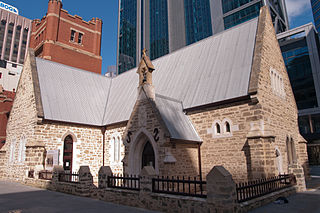
The Old Perth Boys School, located at 139 St Georges Terrace, Perth, Western Australia, is the earliest government school building in Western Australia. The single-storey limestone building was designed by William Ayshford Sanford in 1852 and is a significant example of a colonial building constructed in Perth from the mid-nineteenth century.

The 1910 Perth Technical School building is located at 137 St Georges Terrace, Perth, Western Australia, adjacent to the Old Perth Boys School building, which had served as part of the school's former temporary premises since opening of classes there on 16 May 1900.
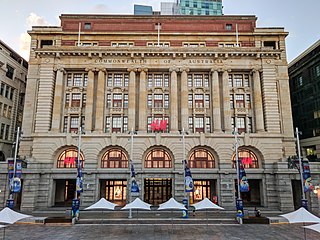
The General Post Office is a heritage landmark building in Perth, Western Australia. Located on the western side of Forrest Place in the city's central business district, its imposing stone facade is in the Beaux-Arts style. The building was completed in 1923 after almost a decade of construction, which was protracted by World War I and the resulting shortages of construction materials. At the time of its opening, it was the largest building in Perth.
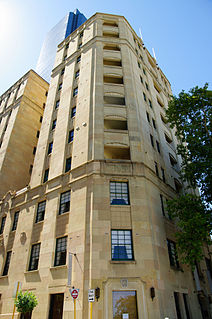
Lawson Apartments are located at 2–4 Sherwood Court near the corner with The Esplanade, in Perth, Western Australia. They are situated across the road from the Esplanade Reserve and adjacent to the Weld Club.
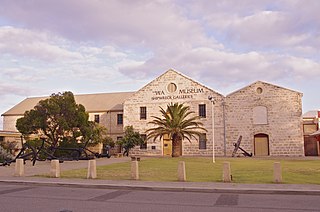
The Commissariat Buildings are a group of two buildings found at 6 Marine Terrace in the West End of Fremantle, Western Australia, which, with construction having begun in 1852, are one of the first sites built using convict labour in the Swan River colony.

Trinity Church is one of the oldest church buildings in the City of Perth, and one of the few remaining 19th-century colonial buildings in the city. It is located at 72 St Georges Terrace in Perth, Western Australia.

The Toodyay Post Office and residence is located in Toodyay, Western Australia on the corner of Stirling Terrace and Duke Street North.
Michael Francis Cavanagh was an Australian architect, primarily known for his work in Western Australia from 1895 to the late 1930s.

York railway station is a disused station on the Eastern Railway in Western Australia. It is located in the town of York.

Avon Terrace it is the main street of the town of York, Western Australia, and is lined with heritage buildings.

The Central Local Court House or Police Law Courts or Central Police Court is a heritage-listed building located at 98 Liverpool Street, in the central business district of Sydney, New South Wales in Australia. Constructed in the Federation Free Classical style based on original designs by Colonial Architect, James Barnet, the building structure was completed in 1892 under the supervision of Barnet's successor, Government Architect, Walter Liberty Vernon. It is also known as Sydney Central Local Court House, Police Law Courts and Central Police Court. The property is owned by the Department of Justice, a department of the Government of New South Wales. It was added to the New South Wales State Heritage Register on 2 April 1999. The court house is located in a precinct that includes the Downing Centre, and buildings housing the Family Court of Australia and the Federal Circuit Court in Sydney. Adjacent to the court house is Brickfield Place, a brick paved courtyard with seating and planter boxes, constructed in 1892, assessed as a good example of urban design for public open space.

York Post Office, on Avon Terrace in York, Western Australia, is the oldest surviving two storey post and telegraph building in Western Australia, and forms part of the heritage-listed town centre complex with the Court House and Police Station (1895). The site has been continuously used as a post office since 1866. The York Post Office was built in response to the town's growing importance as a rural centre and as the town and railway centre closest to the goldfields in the Yilgarn during the initial period of the Western Australian gold rush.

Faversham House is a heritage-listed "grand residence" overlooking Avon Terrace in York, Western Australia. The house, named after the birthplace of John Henry Monger Snr, was built in four stages by the Monger family.
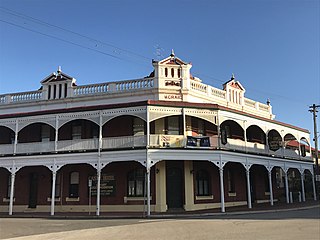
The Castle Hotel in York is reputedly the oldest inland hotel in Western Australia. It was constructed and owned by the Craig family for 137 years.
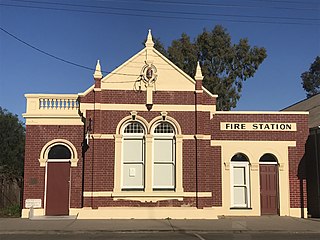
The York Fire Station is a single-storey red brick building originally constructed for the York Municipal Council as Council Chambers in 1897, in York, Western Australia.



















